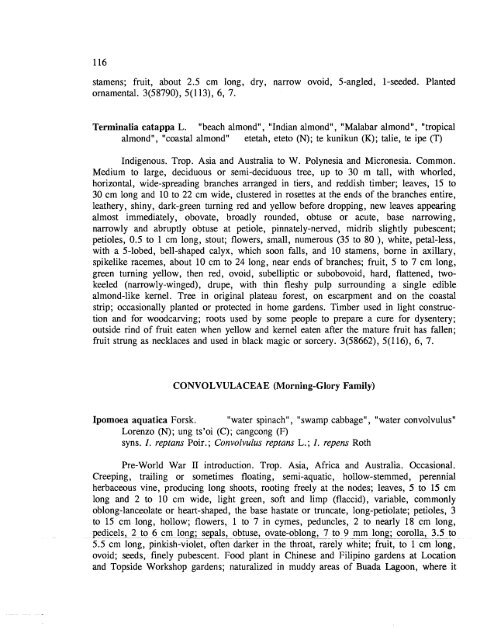atoll research bulletin no. 392 the flora of - Smithsonian Institution ...
atoll research bulletin no. 392 the flora of - Smithsonian Institution ...
atoll research bulletin no. 392 the flora of - Smithsonian Institution ...
Create successful ePaper yourself
Turn your PDF publications into a flip-book with our unique Google optimized e-Paper software.
stamens; fruit, about 2.5 cm long, dry, narrow ovoid, 5-angled, 1-seeded. Planted<br />
ornamental. 3(58790), 5(113), 6, 7.<br />
Terminalia catappa L. "beach almond", "Indian almond", "Malabar almond", "tropical<br />
almond", "coastal almond" etetah, eteto (N); te kunikun (K); talie, te ipe (T)<br />
Indige<strong>no</strong>us. Trop. Asia and Australia to W. Polynesia and Micronesia. Common.<br />
Medium to large, deciduous or semi-deciduous tree, up to 30 m tall, with whorled,<br />
horizontal, wide-spreading branches arranged in tiers, and reddish timber; leaves, 15 to<br />
30 cm long and 10 to 22 cm wide, clustered in rosettes at <strong>the</strong> ends <strong>of</strong> <strong>the</strong> branches entire,<br />
lea<strong>the</strong>ry, shiny, dark-green turning red and yellow before dropping, new leaves appearing<br />
almost immediately, obovate, broadly rounded, obtuse or acute, base narrowing,<br />
narrowly and abruptly obtuse at petiole, pinnately-nerved, midrib slightly pubescent;<br />
petioles, 0.5 to 1 cm long, stout; flowers, small, numerous (35 to 80 ), white, petal-less,<br />
with a 5-lobed, bell-shaped calyx, which soon falls, and 10 stamens, borne in axillary,<br />
spikelike racemes, about 10 cm to 24 long, near ends <strong>of</strong> branches; fruit, 5 to 7 cm long,<br />
green turning yellow, <strong>the</strong>n red, ovoid, subelliptic or subobovoid, hard, flattened, two-<br />
keeled (narrowly-winged), drupe, with thin fleshy pulp surrounding a single edible<br />
almond-like kernel. Tree in original plateau forest, on escarpment and on <strong>the</strong> coastal<br />
strip; occasionally planted or protected in home gardens. Timber used in light construc-<br />
tion and for woodcarving; roots used by some people to prepare a cure for dysentery;<br />
outside rind <strong>of</strong> fruit eaten when yellow and kernel eaten after <strong>the</strong> mature fruit has fallen;<br />
fruit strung as necklaces and used in black magic or sorcery. 3(58662), 5(116), 6, 7.<br />
CONVOLVULACEAE (Morning-Glory Family)<br />
Ipomoea aquatica Forsk. "water spinach", "swamp cabbage", "water convolvulus"<br />
Lorenzo (N); ung ts'oi (C); cangcong (F)<br />
syns. I. reptans Poir.; Convolvulus reptans L.; 1. repens Roth<br />
Pre-World War I1 introduction. Trop. Asia, Africa and Australia. Occasional.<br />
Creeping, trailing or sometimes floating, semi-aquatic, hollow-stemmed, perennial<br />
herbaceous vine, producing long shoots, rooting freely at <strong>the</strong> <strong>no</strong>des; leaves, 5 to 15 cm<br />
long and 2 to 10 cm wide, light green, s<strong>of</strong>t and limp (flaccid), variable, commonly<br />
oblong-lanceolate or heart-shaped, <strong>the</strong> base hastate or truncate, long-petiolate; petioles, 3<br />
to 15 cm long, hollow; flowers, 1 to 7 in cymes, peduncles, 2 to nearly 18 cm long,<br />
pedicels, 2 to 6 cm long; sepals, obtuse, ovate-oblong, 7 to 9 mm long; corolla, 3.5 to<br />
--- -- - -- - - - - - -- - -- -<br />
5.5 cm long, pinkish-violet, <strong>of</strong>ten darker in <strong>the</strong> throat, rarely white; fruit, to 1 cm long,<br />
ovoid; seeds, finely pubescent. Food plant in Chinese and Filipi<strong>no</strong> gardens at Location<br />
and Topside Workshop gardens; naturalized in muddy areas <strong>of</strong> Buada Lagoon, where it

















